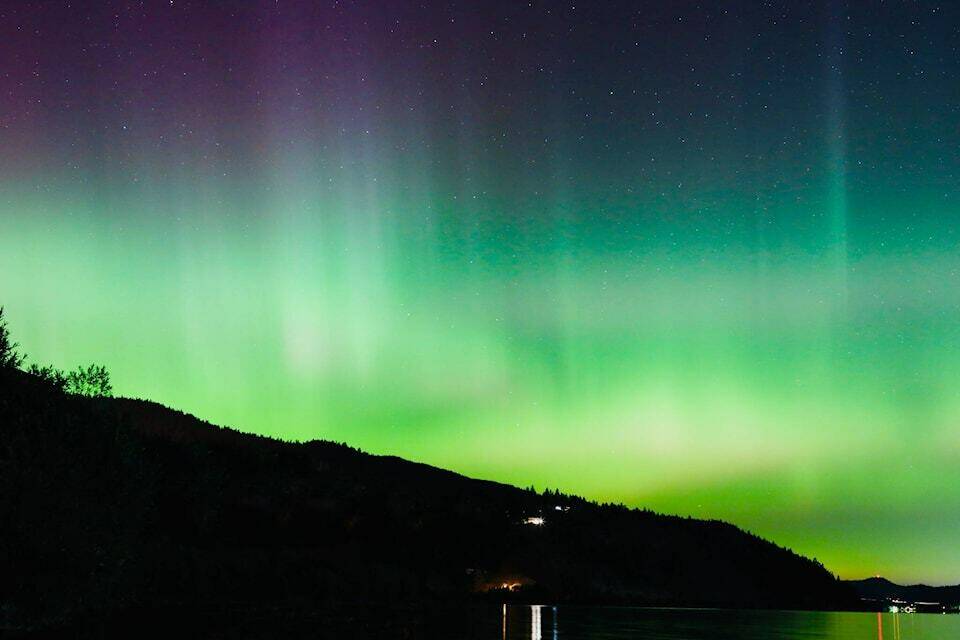Friday evening is looking like it’s going to be a good night to see the northern lights, even if you don’t happen to be in the north.
Canada’s space weather agency is warning of a “major geomagnetic storm” hitting the country tonight.
Not only could it have severe impacts on power systems and other infrastructure, but it could result in the aurora borealis being visible well into the southern U.S.
Space Weather Canada refers to the northern lights, or aurora borealis, as a “spectacular, colourful display of light commonly seen in the night sky in the northern hemisphere.”
The Weather Network is reporting that the best spots to catch a glimpses tonight will be the western Prairies and into British Columbia, with the best time to catch the illuminated skies in B.C. between 8 p.m. and 2 a.m. Saturday.
Space Weather Canada says the lights are a product of massive solar flares was striking all of Canada Friday afternoon.
The U.S. National Oceanographic and Atmospheric Administration issued its first geomagnetic storm watch since 2005 and says the storm is a “potentially historic event.”
A spokesman for electricity provider BC Hydro says it has been preparing for the storm, and such events can potentially cause serious damage to high-voltage transmission systems, leading to outages.
Kevin Aquino says while those effects aren’t expected, BC Hydro staff are monitoring for any impacts.
Space Weather Canada says the storm warning will be downgraded late Friday to a storm watch that will last until Saturday afternoon.
It says major storm activity is associated with very high risk of affects on geostationary satellites, and potential severe disruption to activities involving geomagnetism, including aerial surveys and directional drilling.
The storm could also extend the northern lights across all of Canada and as far south as California.
NOAA alerted operators of power plants and spacecraft in orbit to take precautions, as well as the Federal Emergency Management Agency.
“For most people here on planet Earth, they won’t have to do anything,” said Rob Steenburgh, a scientist with NOAA’s Space Weather Prediction Center.
The storm could produce northern lights as far south in the U.S. as Alabama and Northern California, according to NOAA. But it was hard to predict and experts stressed it would not be the dramatic curtains of color normally associated with the northern lights, but more like splashes of greenish hues.
“That’s really the gift from space weather — the aurora,” said Steenburgh. He and his colleagues said the best aurora views may come from phone cameras, which are better at capturing light than the naked eye.
Snap a picture of the sky and “there might be actually a nice little treat there for you,” said Mike Bettwy, operations chief for the prediction center.
The most intense solar storm in recorded history, in 1859, prompted auroras in central America and possibly even Hawaii. “We are not anticipating that” but it could come close, said NOAA space weather forecaster Shawn Dahl.
This storm — ranked 4 on a scale of 1 to 5 — poses a risk for high-voltage transmission lines for power grids, not the electrical lines ordinarily found in people’s homes, Dahl told reporters. Satellites also could be affected, which in turn could disrupt navigation and communication services here on Earth.
An extreme geomagnetic storm in 2003, for example, took out power in Sweden and damaged power transformers in South Africa.
The sun has produced strong solar flares since Wednesday, resulting in at least seven outbursts of plasma. Each eruption — known as a coronal mass ejection — can contain billions of tons of plasma and magnetic field from the sun’s outer atmosphere, or corona.
The flares seem to be associated with a sunspot that’s 16 times the diameter of Earth, according to NOAA. It’s all part of the solar activity that’s ramping up as the sun approaches the peak of its 11-year cycle.
NASA said the storm posed no serious threat to the seven astronauts aboard the International Space Station. The biggest concern is the increased radiation levels, and the crew could move to a better shielded part of the station if necessary, according to Steenburgh.
Increased radiation also could threaten some of NASA’s science satellites. Extremely sensitive instruments will be turned off, if necessary, to avoid damage, said Antti Pulkkinen, director of the space agency’s heliophysics science division.
Several sun-focused spacecraft are monitoring all the action.
“This is exactly the kinds of things we want to observe,” Pulkkinen said.
—with files from CP and AP
READ MORE: B.C. skies to come alive with more northern lights in the next 3 years: Scientists
READ MORE: Northern lights may end year with a spectacle thanks to solar flare

